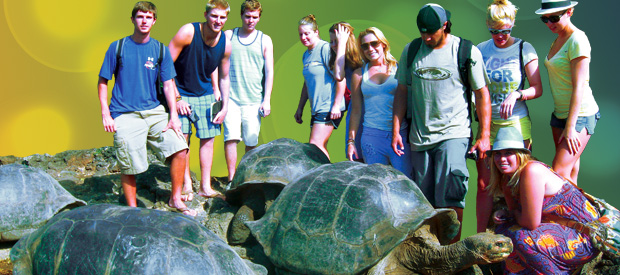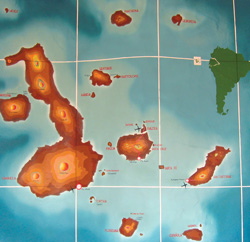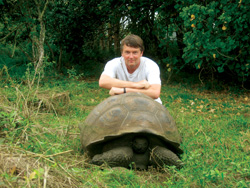An Endemic Experience
Seaver College Students Follow Charles Darwin’s Footsteps in the Galapagos Islands.
The most famous visitor to the Galapagos Islands was undoubtedly the young Charles Darwin, who arrived in 1835 on board HMS Beagle. There he found a remarkable population of endemic species—species unique to the region and found nowhere else in the world. They came to play a vital part in the development of his theories of evolution and natural selection.

When Seaver College sophomore Arthur Sanders heard that Pepperdine was offering its first-ever summer special interest trip to the Galapagos Islands and the Amazon, led by University professors Ed Larson and Rodney Honeycutt, he couldn’t believe his ears.
“I have always been fascinated by exotic animals, especially reptiles, which is why I’m a pre-veterinary student,” Sanders says. “I knew on this trip I would get to observe some of the most unique wildlife in the world in the Galapagos Islands, and get to visit the rainforest; one of my lifelong dreams.”
 Sanders was one of 18 students who traveled to Darwin’s playground and the rainforest
in June 2009. They earned a history credit for taking Science and Religion in the
Western Tradition, a course in which Larson, Hugh and Hazel Darling Chair in Law and
Pulitzer Prize-winning historian, taught students the lessons of evolution. Students
also fulfilled a lab science credit for taking Evolution of Biodiversity in the New
World Tropics with acclaimed biology professor Honeycutt, who “lectured” from a canoe
on the Amazon River.
Sanders was one of 18 students who traveled to Darwin’s playground and the rainforest
in June 2009. They earned a history credit for taking Science and Religion in the
Western Tradition, a course in which Larson, Hugh and Hazel Darling Chair in Law and
Pulitzer Prize-winning historian, taught students the lessons of evolution. Students
also fulfilled a lab science credit for taking Evolution of Biodiversity in the New
World Tropics with acclaimed biology professor Honeycutt, who “lectured” from a canoe
on the Amazon River.
“The Galapagos Islands and the Amazon jungle gives students a tremendous opportunity to experience another culture, plus have a truly unique educational opportunity to see different biological and geological settings,” says Larson, who drew on his more than 20 research trips to the islands to design the curriculum.
They began by navigating around the 13 main islands that make up the Galapagos Archipelago in a massive sailboat. “Time on the boat was considered lab time—we make a lot of stops and it’s an opportunity to get out in the wild and see the animals and habitats and plants in their setting,” Larson explains.
Students were required to read The Beak of the Finch by Jonathan Wiener, about Peter and Rosemary Grant who studied natural selection among finches on the island of Daphne Major. “It’s a good book when read by itself, but the ideas were really brought to life when we actually went by Daphne Major in a boat, and got to see Darwin’s finches firsthand utilizing their unique beak shapes,” says Sanders. “Also, seeing animal adaptations we learned about, such as the different shapes of the Galapagos tortoise shells, on real, living animals really helped the ideas of evolution and natural selection sink in.”
Swimming with sea lions was one of the most memorable experiences for the students. “The first time I went snorkeling, a baby sea lion jumped in the ocean with us and swam around me. This was such an exhilarating experience,” says junior Kendria Smith, who had never been snorkeling, nor set foot outside the United States when she embarked on this journey. “The second time I went snorkeling, a Galapagos penguin jumped in the water too.”

On land the students spent another five days on Santa Cruz Island, where the Darwin Research Station is located. “The main attraction on Santa Cruz is a wonderful laid-back beach life, combined with amazingly fearless animals,” Larson says, noting that Galapagos has no native land mammals, and therefore the birds and reptiles that evolved there have no fear of humans. “Animals go right up to you. Birds land on your shoulders and they don’t move off the path.”
This phenomenon shocked Mason Hankins. “On Española Island there were these mockingbirds endemic only to that island,” he says. “They would hop right up to our group and squawk at us and follow us around. It was the weirdest thing ever.”
Larson calls the Galapagos “an inspiring place for students and for teaching. It’s a wonderful opportunity to see evolution in action and to see a lot of endemic species and how they interrelate with their environment and are finely attuned by the evolutionary process for survival.”
Next destination: Lago Agrio, Ecuador, where the group spent four days navigating the Amazon rainforest via motorized canoes. “I almost feel like a mini-expert after all of the jungle quizzes Dr. Honeycutt gave us,” says Smith, who experienced two new firsts: fishing for piranha and hiking through a lava tube.
“Any student of nature should visit the rainforest within his or her lifetime,” Honeycutt remarks. “The Ecuadorian rainforest provides a natural laboratory for learning about biodiversity and ecology. At the same time places in Ecuador have much to teach us about how over-exploitation of natural resources can endanger natural systems.”
As experts in their respective fields, Larson and Honeycutt were able to customize the learning experience to the interests of the students in their “classroom.” “This group of students took a strong interest in the conservation of these areas,” Larson says, noting that both he and Honeycutt were able to focus on these issues.
“You can definitely tell what human exposure has done to the animals in the past 150-plus years,” laments Hankins.
Much like the endemic species that exist only in the Galapagos and the Amazon rainforest, the students report that their summer learning adventure could have never existed anywhere else outside of these remarkable habitats, this group, or without the insights of their trusty guides.
“I learned through this trip that less really is more,” says senior Timothy Maki. “So often we fill our lives with all this unnecessary stuff that we don’t even get time to stop, reflect, and appreciate where we are and how far we’ve come.”
Smith says she not only learned important educational concepts, but also, what she’s made of. “The overall experience of being immersed in a different country and learning to navigate my way through it is something I could never learn in a classroom.”
